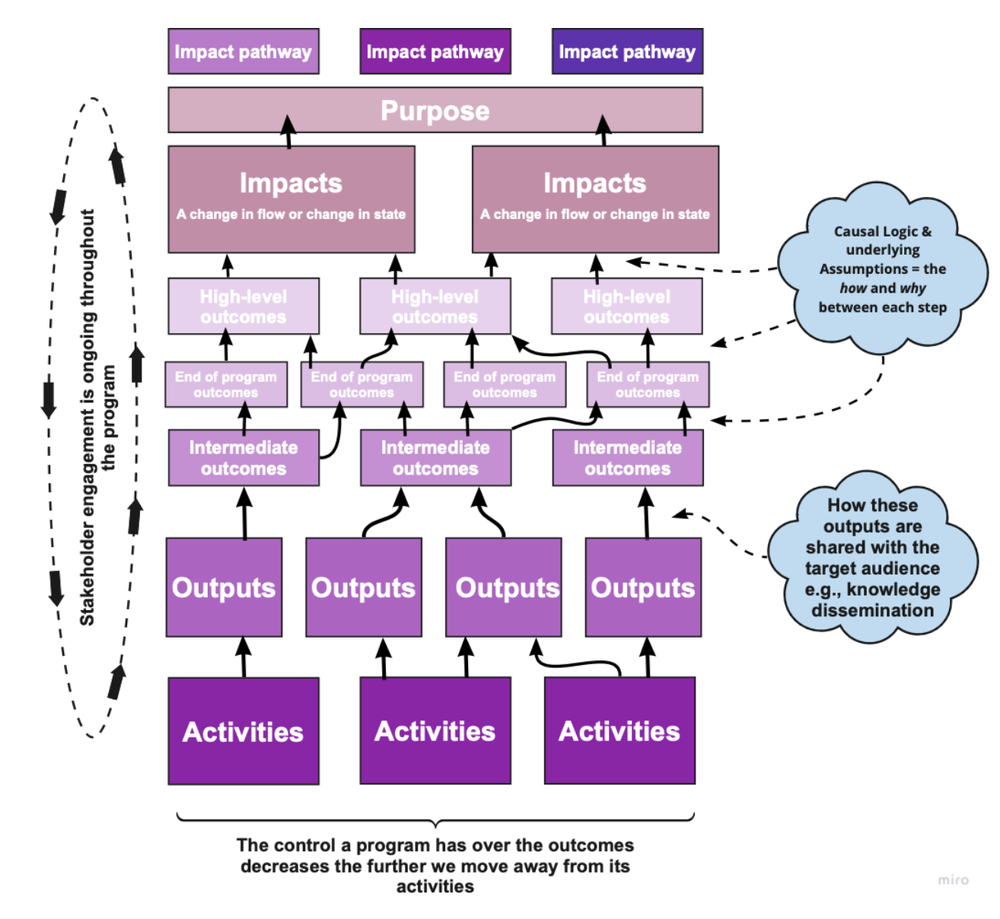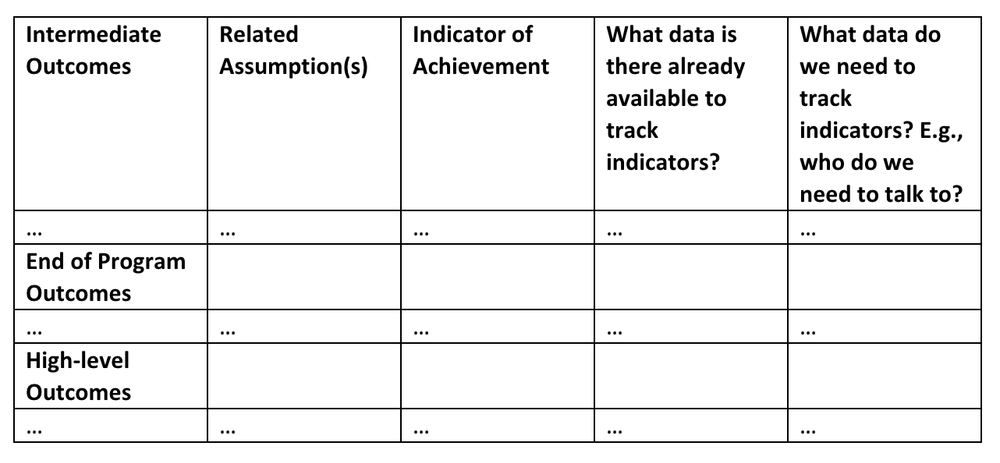This is an Eval Central archive copy, find the original at evalacademy.com.
We get it, Theory of Change (ToC) doesn’t really sound like the most fun, interesting, or appealing evaluation tool. I certainly wasn’t buzzing with excitement when I first heard the phrase ToC!
If this also sounds like you, then you’ve come to the right place. This article aims to introduce you to ToC and is aimed at those who may have heard of the tool before but aren’t quite sure as to what it is and how it can be useful for evaluation. After putting my preconceptions of the tool to one side and learning more about its uses, I have found that ToC has been one of the most valuable tools to me so far as an evaluator.
This article is the first part of our discussion on ToC and answers the question of “what is theory of change in evaluation?”
The second part of our discussion will focus on how to develop and use ToC for evaluation.
So, what is Theory of Change (ToC)?
Theory of Change (ToC) explains how a set of activities will solve a problem. It does this by clearly describing the problem and the change you (and the program) intend to create.
Most importantly, ToC depicts change that is not linear. Processes of change actually have multiple feedback loops that need to be understood and described.
In short, ToC is a diagram to describe “if you do this, then these are the intended results.” When we break it down a little more we get …

Although ToC has similar components to other evaluation tools such as logic models that mainly focus on the what, ToC goes into more detail about the why.
It does this by identifying processes called “causal logic” or “causal mechanisms” which are represented in the diagram using arrows. We will go into further detail about causal logic below.
While logic models also highlight contextual factors and assumptions, they are often focused at a high-level and don’t look at each specific step within the change process (e.g., between each outcome box). This is something that is key to a ToC.
ToC allows us to map each step towards a long-term goal which provides an explicit and testable diagram of how and why a change is expected to happen in a particular context.
It is not just a list of activities with arrows linking them to their intended outcomes like a logic model, but it explains how these changes will happen and how the program will contribute to this change at each little step in the change process.
You guessed it, ToC creates its own program theory. It also looks at what other external factors outside of the program will affect the desired change.
ToC can be developed for any level of an intervention – an event, a project, a program, a policy, a strategy, or an organization.
This makes it both useful for program planning and in monitoring and evaluation where it is often captured through a one-page diagram that contains multiple boxes and arrows. This diagram often has a supporting written narrative that explains each step of the theory in more detail to walk the reader through the diagram.
A ToC is a living document; it is not set in stone and should be revisited and revised as the program progresses to make the most of opportunities and address challenges that arise. Depending on the lifespan of the program, a 6-monthly or yearly review of the ToC diagram and narrative might be appropriate.
What are the main components of a Theory of Change (ToC)?
There are several main components of a ToC. Some of these components are included in the ToC diagram itself, while others should be captured in the supporting narrative or an alternate table. This has been explained in further detail below.
-
Activities are the actions that will be taken by the program that are expected to contribute to the change. For example, this could include interviews with patients, training of clinicians, etc.
-
Outputs are the products or the services that the program will create through the activities. For example, certain pieces of new knowledge (e.g., patients’ opinions) or new processes (e.g., a new clinic workflow).
-
Outcomes are the changes in knowledge (e.g., clinicians have greater understanding of a condition), attitudes (e.g., patients change their perspectives about exercise), or skills (e.g., clinicians learn how to use new software) of the key actors that are expected to lead to a change in their behaviour (e.g., clinicians use their knowledge to support patients, patients exercise 3 times a week, MOA’s use TNA for tracking appointments). Outcomes are sometimes broken down into intermediate, end of program, and high-level depending on when they are expected to be realized in the program life cycle. However, there is no right number of outcomes which entirely depends on the program itself and the change process they are describing.
-
Impacts are the top-level changes that result wholly or in part from the outcomes (e.g., the change process) to which the program contributed to.
-
Purpose is the overall goal/aim the program aims to contribute to; it explains the program’s reason for existence. Unlike a Vision Statement which is more high-level and focuses on the what, the program’s purpose focuses on the why. For example, why is your program on the journey it’s on?
-
Impact Pathways are the pathways through which the program is expected to contribute to change. These are often actor specific to make them more tangible (e.g., Clinician Capacity Building Pathway, Clinic Workflow Pathway)
-
Causal Logic describes the how and why between each step in a ToC. In the ToC diagram it is often presented using arrows. More detail about the causal logic is captured within the supporting narrative.

Example ToC diagram structure
Main components that need to be captured outside of the TOC diagram:
-
Key Actors are the people who are crucial to the program. Those developing a ToC should be aware of the key actors’ roles within the context of the program, and how the program will work with these key actors to create change. Key actors can be identified using the framing of “who is doing what differently and why as a result of the program?” and captured using a Stakeholder Matrix (our template can be found here).
-
Causal Logic describes the how and why between each step in a ToC. Detail about the causal logic which links each step in the ToC diagram is captured using the descriptive narrative that accompanies the diagram. The narrative walks the reader step-by-step through the diagram.
-
Indicators are a marker of accomplishment that can be used to measure the success of a program (e.g., did the program contribute to a certain outcome?). These play a key role in the evaluation plan and can be captured and listed using the suggested ToC tracking table below.
-
Assumptions are the factors outside of the program’s control that are necessary to ensure the program’s success. This is one of the most valuable parts of the ToC process as stakeholders get to hear each other’s understanding of the goals, challenges, and what is needed in the program’s context for it to succeed. Like indicators, it is very important to list and understand these key assumptions as they relate to each individual outcome.

Example of a Theory of Change (ToC) tracking table
Why should I use a Theory of Change (ToC)?
ToC can help you to understand why change is expected to occur by altering the way you think about your program from what you are doing to what you want to achieve. The tool can also help programs respond to changes and guide stakeholder engagement, communication, and support decision-making.
By defining long-term goals and then mapping backwards to identify the necessary preconditions, ToC can provide the basis for arguing that a program is making a difference whilst identifying weaknesses in the argument and providing the opportunity to make changes.
It is well suited to complex programs that are influenced by multiple systems and actors due to its fluid, yet comprehensive approach.
Why is ToC useful for evaluation?
-
ToC essentially provides a diagram that can be tested by analyzing relevant indicators to see if the program actually contributed to the intended change
-
ToC builds a solid foundation for an impact evaluation by providing a reporting framework and identifying what data needs to be gathered to test the theory
-
A well-developed ToC can help to create better key evaluation questions, identify indicators for monitoring change, and identify gaps in available data
-
This can help to focus new data collection on areas where there are gaps leading to more effective use of evaluation resources
-
By identifying the why and how of a program, ToC can help to reflect on what has worked or not worked to understand the past, identify opportunities for learning, and plan for the future
However, developing a ToC can be challenging as it involves facilitating collaboration with all key stakeholders, synthesizing a range of views and information sources, as well as obtaining agreement and buy-in from stakeholders. The collaborative aspect of developing a ToC is crucial and will be further discussed in part 2 of our series on ToC.
How has Theory of Change (ToC) helped me in my evaluations?
ToC has played a BIG part in my role as an evaluator so far in helping me to deliver meaningful results to stakeholders. It has also helped me to build an understanding of change processes and increase the capacities of key stakeholders to do the same.
Collaboratively developing a ToC before the start of a program has supported my clients in identifying how and why the program is expected to lead to the desired change. It has helped my clients to become clearer in their own understanding, highlight gaps they may not have considered, and document their own underlying assumptions. ToC helped my clients to better understand risk and opportunity within their program’s context to ensure success.
Collaboratively developing a ToC after a program has been launched for evaluation purposes has also benefitted my clients by helping them to understand why they made certain decisions and why they collaborated with certain actors. As well as providing me with a clear evaluation framework, ToC has helped me to provide actionable recommendations and results. Using ToC as an evaluation tool has also helped my clients to learn more about the benefits of having a clear ToC from the program’s start to help them make decisions and guide their program through challenges.
Have you worked with ToC before, or have questions? Comment on this article or connect with us on LinkedIn or Twitter!
Sign up for our newsletter
We’ll let you know about our new content, and curate the best new evaluation resources from around the web!
We respect your privacy.
Thank you!